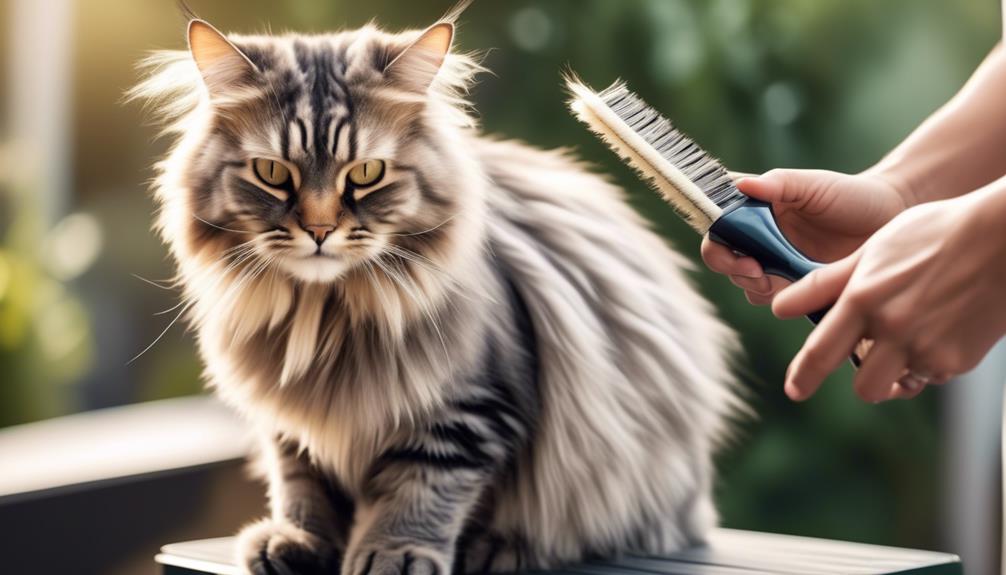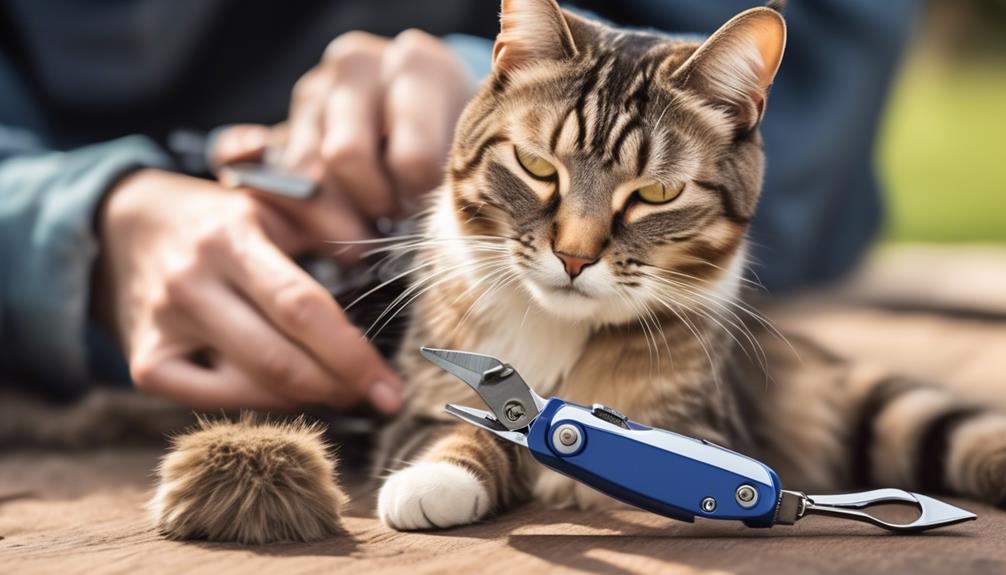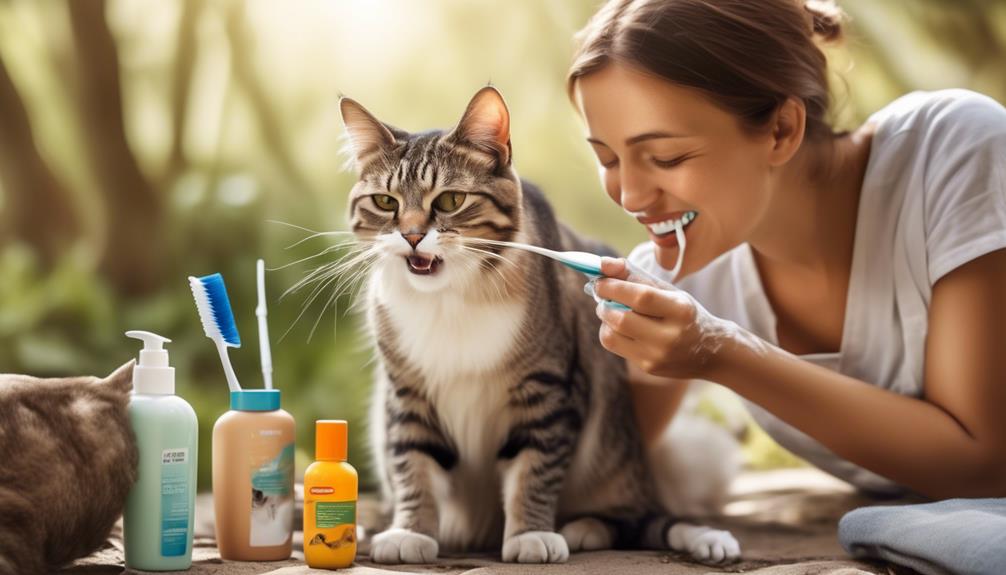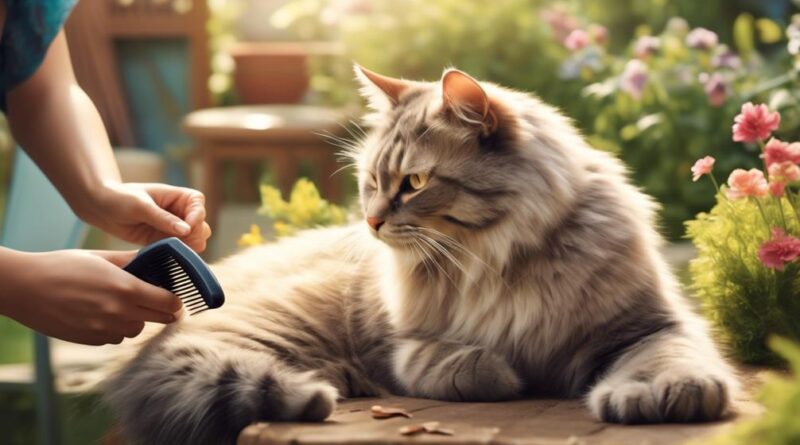12 Essential Tips for Grooming Outdoor Cats
Have you ever wondered how to keep your outdoor cat looking and feeling their best? Grooming plays a crucial role in not only maintaining your feline friend's appearance but also in promoting their overall health and well-being.
From brushing and bathing to preventive care against pests, there are several essential tips to consider when it comes to grooming your outdoor cat. These tips can make a significant difference in your cat's comfort and happiness, so it's important to ensure you're doing it right.
Brushing Frequency

To maintain your outdoor cat's coat health, regular brushing is essential to minimize matting and tangles. Shedding management is crucial for outdoor cats, and grooming tools such as slicker brushes and shedding combs are your best allies. Aim to brush your outdoor cat at least 2-3 times a week, increasing the frequency during shedding seasons. This regular brushing helps to remove loose fur, preventing it from forming mats and tangles.
When it comes to mats and tangles, dematting techniques are necessary to keep your outdoor cat's coat in top condition. Mats can be gently loosened using a dematting comb or tool, starting at the tip of the mat and working your way inward. If the mat is too large or close to the skin, it's best to seek professional help to avoid causing your cat any discomfort. Regular brushing not only prevents mats from forming but also allows you to detect them early on, making them easier to address.
Bathing Techniques
Maintain your outdoor cat's hygiene by using gentle bathing techniques to keep their coat clean and healthy. When bathing your outdoor cat, it's essential to use a mild cat-specific shampoo to avoid stripping their coat of natural oils. Before wetting your cat, brush their fur to remove any loose dirt and mats. Once your cat is wet, apply the shampoo sparingly, massaging it into their coat to ensure it reaches the skin. This will help with coat conditioning and skin moisturizing, preventing dryness and irritation.
When rinsing, make sure to thoroughly remove all traces of shampoo, as leftover residue can cause skin irritation. After bathing, gently towel-dry your cat to remove excess water. If your cat tolerates it, you can use a blow dryer on the lowest setting to finish drying their coat.
It's important to note that not all outdoor cats will tolerate baths, and forcing a cat into the water can cause distress. If your cat is particularly averse to water, consider using waterless shampoos or wipes specifically designed for cats. These products can help freshen your cat's coat without the need for a full bath.
Additionally, regular brushing and grooming can help reduce the frequency of baths, keeping your outdoor cat clean and comfortable.
Flea and Tick Prevention

To protect your outdoor cat from fleas and ticks, regularly apply a vet-recommended topical treatment. Fleas and ticks are common pests that can cause discomfort and transmit diseases to your cat. There are various preventative measures and treatment options available to keep your feline friend safe from these parasites.
When it comes to flea and tick prevention, it's essential to consider both natural remedies and chemical treatments. Natural remedies such as essential oils like cedarwood, lavender, and eucalyptus can act as natural repellents for fleas and ticks. However, it's crucial to consult with your veterinarian before using any natural remedies, as they can be toxic to cats if not used properly.
On the other hand, chemical treatments like spot-on treatments, flea collars, and oral medications are effective in preventing and treating flea and tick infestations. These products are often recommended by veterinarians and can provide long-lasting protection against these parasites. Be sure to follow the instructions provided by the manufacturer and consult your vet if you have any concerns about using chemical treatments.
In addition to applying preventative treatments, regularly grooming your outdoor cat can help you spot any signs of flea or tick infestations early on. This allows for prompt intervention and treatment, preventing the problem from escalating. By combining preventative measures and proactive grooming, you can effectively protect your outdoor cat from fleas and ticks.
Ear and Eye Care
Regularly grooming your outdoor cat not only helps in preventing flea and tick infestations but also allows you to observe any signs of potential ear and eye issues early on. When it comes to ear care, it's essential to check for ear mites, which can cause discomfort and irritation for your cat. If you notice your cat excessively scratching their ears or shaking their head, it may indicate the presence of ear mites. In such cases, consult your veterinarian for appropriate ear mite treatment. Additionally, regular ear cleaning can help prevent ear mite infestations and other ear-related issues. Use a veterinarian-approved ear cleaning solution and gently wipe the visible parts of the ear with a cotton ball or pad.
As for eye care, preventing eye infections is crucial. Keep an eye out for any signs of redness, discharge, or squinting, as these could indicate an eye infection. It's also important to protect your cat from potential eye irritants such as dust, pollen, and smoke. If you notice any eye-related concerns, consult your veterinarian promptly. You can also gently clean around the eyes with a damp, soft cloth to remove any debris or irritants that may have accumulated.
Nail Trimming

When trimming your outdoor cat's nails, ensure that you use proper pet nail clippers and approach the task calmly to minimize any discomfort for your feline friend. It's important to make your cat feel as comfortable as possible during this grooming process.
Here are some essential tips for nail trimming:
- Scratching Alternatives: Providing your outdoor cat with scratching posts or pads can help keep their nails naturally trimmed. Encourage your cat to use these alternatives by sprinkling catnip on them or gently guiding your cat's paws to the scratching surface.
- Health Benefits: Regular nail trimming is crucial for your outdoor cat's health. Overgrown nails can curl into the paw pads, leading to pain and potential infection. Keeping their nails trimmed also reduces the risk of them getting caught on outdoor objects or surfaces.
- Professional Assistance: If you're unsure about trimming your cat's nails, seek professional assistance from a veterinarian or a trained groomer. They can demonstrate the proper technique and provide guidance on handling your cat during nail trimming.
- Training Methods: Gradually accustom your outdoor cat to having their paws handled from a young age. Use positive reinforcement, such as treats and praise, to create a positive association with nail trimming. This can help reduce stress and resistance during the process.
Coat Care
Ensure that you regularly brush your outdoor cat's coat to remove loose fur and prevent matting. Shedding management is essential for outdoor cats, especially during seasonal changes. Brushing your cat's coat helps to minimize the amount of loose hair that they might ingest while grooming themselves, reducing the risk of hairballs and digestive issues. It also helps to control the amount of loose fur that ends up around your home and on your furniture.
In addition to shedding, mat removal is crucial for outdoor cats. Mats can form in your cat's fur, particularly in areas where they're more prone to getting wet or dirty. Regular brushing not only reduces shedding but also helps to prevent mats from forming. If you notice any mats in your cat's fur, gently work through them with a comb or brush to prevent them from becoming larger and more uncomfortable for your cat.
To effectively manage shedding and mat removal, establish a consistent grooming routine for your outdoor cat. Brushing your cat's coat a few times a week can significantly reduce the amount of loose fur and prevent mats from forming. Remember to use a brush or comb that's suitable for your cat's coat type, and be gentle and patient during the grooming process.
Regular coat care not only keeps your outdoor cat looking their best but also contributes to their overall health and well-being.
Dental Hygiene

Regular brushing your outdoor cat's teeth is essential for maintaining their dental hygiene and overall health. Just like humans, cats can suffer from dental issues such as tartar buildup, gum disease, and tooth decay.
To keep your outdoor cat's teeth and gums healthy, here are some important tips to follow:
- Proper diet: Feeding your outdoor cat high-quality cat food and providing dental treats specifically designed to promote oral health can help reduce plaque and tartar buildup. Avoid feeding your cat a diet solely consisting of soft food, as this can contribute to dental problems.
- Regular check-ups: Schedule regular dental check-ups with your veterinarian to monitor your cat's dental health. Your vet can perform professional cleanings and address any dental issues early on, preventing them from escalating into more serious problems.
- Brushing their teeth: Introduce your outdoor cat to tooth brushing at a young age to get them used to the routine. Use a cat-specific toothbrush and toothpaste, as human toothpaste can be harmful to cats. Brushing their teeth regularly can help prevent dental issues and keep their breath fresh.
- Chew toys: Providing dental chew toys can help keep your outdoor cat's teeth clean by reducing plaque and massaging their gums. Look for toys specifically designed to promote dental health.
- Monitor their dental health: Keep an eye out for signs of dental issues such as bad breath, swollen gums, or difficulty eating. If you notice any of these symptoms, consult your veterinarian promptly.
Seasonal Grooming
To keep your outdoor cat's coat healthy and free from mats and tangles, regularly grooming them according to the changing seasons is essential. Shedding management is particularly important as the weather shifts. As the weather warms up, your cat will shed their winter coat to prepare for the warmer months. Brushing your cat more frequently during this time can help reduce the amount of loose fur around your home and prevent your cat from ingesting too much fur while grooming themselves. Use a slicker brush or a shedding tool to effectively remove loose fur without causing any discomfort to your furry friend.
On the other hand, as the weather turns cooler, your outdoor cat's fur will become thicker and denser. This can lead to an increased risk of fur matting, especially if your cat spends a lot of time outdoors. To prevent fur matting, consider using a wide-toothed comb to gently detangle any knots or mats that may have formed. Additionally, grooming your cat more frequently during this time can help prevent mats from becoming more severe.
It's also important to consider weather conditions when grooming your outdoor cat. If it's particularly wet or muddy outside, your cat's fur may become dirty more quickly. Regular grooming with the appropriate tools, such as a grooming glove or a damp cloth, can help keep your cat's fur clean and free from dirt and debris.
Frequently Asked Questions
How Can I Train My Outdoor Cat to Tolerate Grooming Sessions?
To train your outdoor cat to tolerate grooming sessions, use gentle training techniques. Understand outdoor cat behavior and grooming challenges. Regular brushing helps control shedding. Consider climate impact. Patience and consistency will lead to success.
Are There Any Specific Products or Tools That Are Best for Grooming Outdoor Cats?
For grooming outdoor cats at home, the best grooming products and tools include a flea comb, deshedding brush, and cat-specific shampoo. Use gentle techniques to make grooming sessions comfortable and stress-free for your outdoor cat.
What Are Some Signs That My Outdoor Cat May Need Professional Grooming or Veterinary Care?
If your outdoor cat is showing signs of stress or illness like changes in behavior, appetite, or grooming habits, it's crucial to seek professional grooming or veterinary care. Regular check-ups are important for maintaining your cat's health and well-being.
How Can I Prevent My Outdoor Cat From Getting Mats or Tangles in Their Fur?
To prevent mats in your outdoor cat's fur, brush regularly and check for tangles. Understanding your cat's behavior and grooming techniques can help keep their fur healthy. Maintaining their coat will also contribute to their overall health.
Are There Any Special Considerations for Grooming Outdoor Cats in Different Climates or Environments?
When grooming outdoor cats, climate impact can pose grooming challenges. Consider using deshedding tools in hot climates to reduce shedding and mats, and in cold climates, provide extra insulation and protection for their fur.
Conclusion
Now that you have all the essential tips for grooming your outdoor cat, you can keep them looking and feeling their best.
Remember to brush them regularly, use gentle bathing techniques, and keep an eye out for fleas and ticks.
Don't forget to trim their nails, clean their ears and eyes, and take care of their dental hygiene.
With seasonal grooming and proper coat care, your outdoor cat will stay happy and healthy for years to come.
